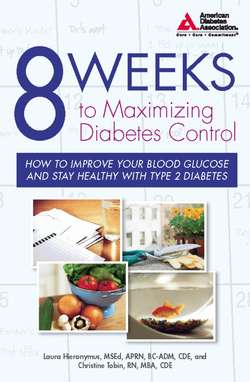Читать книгу 8 Weeks to Maximizing Diabetes Control - Laura Hieronymus - Страница 10
На сайте Литреса книга снята с продажи.
ОглавлениеCHAPTER 3
Being Active—The Magic of Movement
Being more active on a daily basis improves your overall physical health. Individuals who exercise regularly report increased self-esteem, reduced stress, and enhanced clarity of thought—who would argue with that? Routine physical activity also improves your confidence in your ability to make a behavior change. No matter what type of exercise and physical activity you choose to do, all of it counts toward better health outcomes.
What’s in It for Diabetes?
Not only does being more physically active actually prevent diabetes, offers the benefit of improving diabetes control by lowering blood glucose readings and decreasing body fat. The benefits of physical activity include weight control, and when moderate-to-intense aerobic physical activity is done regularly, the risk for cardiovascular disease declines. In fact, the American Diabetes Association recommends exercise and physical activity as an essential part of the treatment plan for type 2 diabetes.
HEALTH BENEFITS OF EXERCISE: THE BOTTOM LINE
• Preserves mobility, strength, and balance
• Increases bone density and strength
• Boosts brainpower and memory
• Reduces the risk of certain cancers
• Reduces cravings for alcohol, nicotine, caffeine, and sugar
• Improves insulin sensitivity, decreasing cardiometabolic risks
• May improve fibrinolysis (dissolving of blood clots)
• May prevent progression of type 2 diabetes
• Improves overall psychological well-being
People with type 2 diabetes have insulin resistance, where muscle, fat, and liver cells do not respond normally to insulin. As a result, it takes more insulin than normal to get glucose into the cells energy. Exercise can benefit the body by improving sensitivity to insulin, helping the body use insulin better. Since lipids (blood fat levels) and blood pressure are a concern to those people with type 2 diabetes, improvement in exercise can translate into lower total cholesterol, LDL bad) cholesterol, and triglyceride levels, as well as lower blood pressure. Exercise has also been found to improve HDL (good) cholesterol levels, which is added protection against heart disease.
The Magic of Movement
The 1996 report of the Surgeon General states that for the general adult population: “…significant health benefits can be obtained by including a moderate amount of physical activity (30 minutes of brisk walking or raking leaves, 15 minutes of running, or 45 minutes playing volleyball), on most days of the week.” The report outlines moderate amount of physical activity equivalent to any activity that burns 150 calories of energy per day, or 1,000 calories per week, with greater health benefits achieved by increasing the amount (duration, frequency, or intensity) of physical activity.
For those individuals with diabetes who are not able to set aside at least 30 minutes at a time for physical activity, research has shown that your heart and lung fitness gains are similar when your physical activity occurs in several short sessions—10 minute increments three times daily—as when the same total amount and intensity of activity occurs in one 30 minute session. The goal is to accumulate physical activity over the course of the day. So, washing windows can be as important as water aerobics to improving your overall fitness efforts.
The American Diabetes Association Standards of Medical Care include the types of exercise based on the 1996 report of the Surgeon General, in which the following definitions are outlined in physical activity and health.
Physical activity
Physical activity is defined as bodily movement produced by the contraction of skeletal muscle that requires energy expenditure in excess resting energy expenditure. This includes any activity that keeps you moving—walking across the parking lot and going up (and down) a staircase are two examples of physical activity.
Exercise
Exercise is a subset of physical activity: planned, structured, and repetitive bodily movements performed to improve or maintain one more component of physical fitness. Types of exercise include aerobic and resistance training. Anytime you go from being sedentary to pursuing an exercise program, it is essential that you talk with your diabetes care team on how to get started.
Aerobic exercise
Aerobic exercise consists of rhythmic, repeated, and continuous movements of the same large muscle groups for at least 10 minutes a time, and includes walking, bicycling, jogging, swimming, and water aerobics, and playing most sports.
An effective physical activity program includes a proper warm up and cool down period along with the aerobic period. It is especially important for people with diabetes to take time to warm up, stretch, and cool down to improve their flexibility and to lower their risk for heart problems.
• The warm up prepares the muscles, heart, and lungs for more vigorous activity. A good warm up starts with 5–10 minutes of low-level aerobic activity, such as walking or cycling.
• Gentle stretching for 5–10 minutes follows the warm up. The stretches should include the muscles that will be used during the upcoming active portion of the workout.
• After warming up and stretching the muscles, your body is ready for the aerobic exercise portion. Aerobic exercise is exercise that raises your heart rate and requires an increase in oxygen over an extended period of time, which exercises the heart and lungs, as well as burning fat. Examples of aerobic exercise include brisk walking, running or jogging, swimming, cross-country skiing, ice skating, cycling, rollerblading, jumping rope, water aerobics, and aerobic dance.
